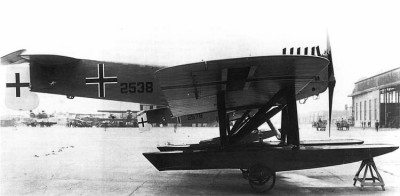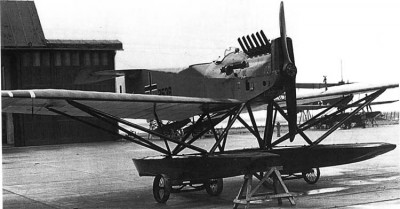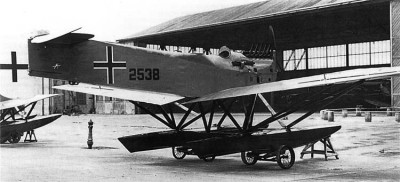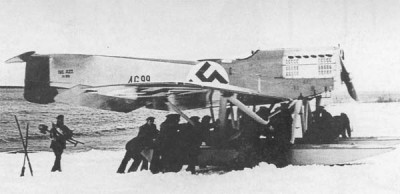| Název: Name: | Hansa-Brandenburg W.33 | Hansa-Brandenburg W.33 |
| Originální název: Original Name: | Hansa-Brandenburg W.33 | |
| Kategorie: Category: | stíhací letoun | fighter aeroplane |
| Výrobce: Producer: | DD.MM.1918-DD.MM.1918 Hansa und Brandenburgische Flugzeugwerke AG, Briest | |
| Období výroby: Production Period: | DD.MM.1918-DD.MM.1918 | |
| Vyrobeno kusů: Number of Produced: | 26 | |
| První vzlet: Maiden Flight: | DD.MM.RRRR | |
| Osádka: Crew: | 2 | |
| Základní charakteristika: Basic Characteristics: | ||
| Vzlet a přistání: Take-off and Landing: | CTOL - konvenční vzlet a přistání | CTOL - conventional take-off and landing |
| Uspořádání křídla: Arrangement of Wing: | jednoplošník | monoplane |
| Uspořádání letounu: Aircraft Concept: | klasické | conventional |
| Podvozek: Undercarriage: | pevný | fixed |
| Přistávací zařízení: Landing Gear: | plováky | floats |
| Technické údaje: Technical Data: | ||
| Hmotnost prázdného letounu: Empty Weight: | 1420 kg | 3131 lb |
| Vzletová hmotnost: Take-off Weight: | 2050 kg | 4519 lb |
| Maximální vzletová hmotnost: Maximum Take-off Weight: | ? kg | ? lb |
| Rozpětí: Wingspan: | 15,85 m | 52ft |
| Délka: Length: | 11,10 m | 36ft 5in |
| Výška: Height: | 3,37 m | 11ft 0,68in |
| Plocha křídla: Wing Area: | 44,6 m2 | 480.07 ft2 |
| Plošné zatížení: Wing Loading: | ? kg/m2 | ? lb/ft2 |
| Pohon: Propulsion: | ||
| Kategorie: Category: | pístový | piston |
| Počet motorů: Number of Engines: | 1 | |
| Typ: Type: | Maybach Mb.IVa o výkonu 180 kW/245 k dvoulistá dřevěná vrtule | Maybach Mb.IVa, power 242 hp two-blade wooden propeller |
| Objem palivových nádrží: Fuel Tank Capacity: | 330 kg | 728 lb |
| Výkony: Performance: | ||
| Maximální rychlost: Maximum Speed: | 173 km/h v 0 m | 107.5 mph in 0 ft |
| Cestovní rychlost: Cruise Speed: | 160 km/h v ? m | 99.4 mph in ? ft |
| Rychlost stoupání: Climb Rate: | 2,8 m/s | 551.2 ft/min |
| Čas výstupu na výšku: Time to Climb to: | 5,4 min do 1000 m | 5,4 min to 3281 ft |
| Operační dostup: Service Ceiling: | 4800 m | 15748 ft |
| Dolet: Range: | 640 km | 397.7 mi |
| Maximální dolet: Maximum Range: | ? km | ? mi |
| Výzbroj: Armament: | 2x 7,92mm pevný kulomet LMG.08 1x 7,92mm pohyblivý kulomet Parabellum LMG.14 | 2x fixed 7,92mm LMG.08 machine gun 1x flexible 7,92mm Parabellum LMG.14 machine gun |
| Uživatelské státy: User States: | | |
| Poznámka: Note: | Vytrvalost: 4 h | Endurance: 4 hr |
| Zdroje: Sources: | Kroschel, G., Stützer, H. Die deutschen Militärflugzeuge 1910 - 1918. Weltbild Verlag, Augsburg 1994. ISBN 3-89350-693-4. Gray, Peter, Thetford, Peter. German Aircraft Of The First World War. Doubleday, Garden City 1970. Lamberton, W. M. Fighter Aircraft of the 1914-1918 War. Harleyford Publications Ltd, Letchworth 1960. http://www.airwar.ru/enc/fww1/w33.html http://www.aviastar.org/air/germany/hansa_w-33.php | |
| Period | - |
| Producer | - |
| Type | - |
| Camouflage | - |
| Country | - |
| Pilot | - |
| Production No. | - |
| Serial No. / Evidence No. | - |
| Tactical Marking / Imatriculation | - |
| Name | - |
| Unit | - |
| Base | - |
| Date (DD.MM.RRRR) | - |
| Author | - |
| Print size / 300 DPI | - |
| Published with authors permit | - |
| Author Website | - |
| Period | - |
| Producer | - |
| Type | - |
| Camouflage | - |
| Country | - |
| Pilot | - |
| Production No. | - |
| Serial No. / Evidence No. | - |
| Tactical Marking / Imatriculation | - |
| Name | - |
| Unit | - |
| Base | - |
| Date (DD.MM.RRRR) | - |
| Author | - |
| Print size / 300 DPI | - |
| Published with authors permit | - |
| Author Website | - |
| Period | - |
| Producer | - |
| Type | - |
| Camouflage | - |
| Country | - |
| Pilot | - |
| Production No. | - |
| Serial No. / Evidence No. | - |
| Tactical Marking / Imatriculation | - |
| Name | - |
| Unit | - |
| Base | - |
| Date (DD.MM.RRRR) | - |
| Author | - |
| Print size / 300 DPI | - |
| Published with authors permit | - |
| Author Website | - |



